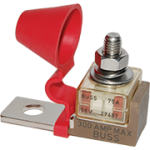shade
Well-known member
I'll have a tally, but I expect it to be around $3500 - $4000 when all of the wiring is added in. That would be the system price, which won't include tools like crimpers or a bench-top power supply. Going for a 160Ah battery added some costs over a more common capacity of 100Ah, but the price per Ah on that model was too good to pass up. Everything in my plan would be useful with a lead battery system, and that single change would reduce cost by $1500.I would be curious to see a total cost figure when it's all said and done. Won't be cheap, but lots of power is quite valuable.
I think this is one of those projects where it's better to commit to either going the bargain route (DIY LFP battery in particular) or more to the top end. Either way can work well, but trying to hit the middle on price may be more difficult. Which corners do you cut, and how will that impact the system?
Managing an LFP battery system is new for me, and I didn't want to take on a DIY battery project at this time. I may change my mind in the future, and I've enjoyed reading about battery building. Past that, once I decided on a Victron battery, staying within their system made sense, even if I could save some money using non-Victron parts elsewhere. As the market matures and more solutions become available, it'll be easier for a DIYer to handle system integration. At the moment, I have more money than time or experience, so spending more to have Victron do that work is worth it to me.
Last edited:

